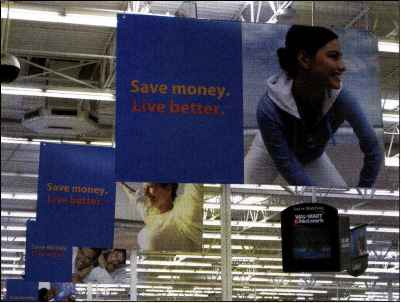Relative Prices
Retailers can also be classified according to the prices they charge (see Table 13.1). Most retailers charge regular prices and offer normal-quality goods and customer service. Others offer higher-quality goods and service at higher prices. The retailers that feature low prices are discount stores and "off-price" retailers.
Discount Stores. A discount Store sells standard merchandise at lower prices by accepting lower margins and selling higher volume. The early discount stores cut expenses by offering few services and operating in warehouse-like facilities in low-rent, heavily traveled districts. Today's discounters have improved their store environments and increased their services, while at the same time keeping prices low through lean, efficient operations. Leading discounters now dominate the retail scene, and world-leading retailer Wal-Mart— what one financial guru calls "the retailing machine of all time"—dominates the discounters (see Real Marketing 13.1).9
Off-price retailer
A retailer that buys at less-than-regular wholesale prices and sells at less than retail. Examples are factory outlets, independents, and warehouse clubs.
Independent off-price retailer
An off-price retailer that is either independently owned and run or is a division of a larger retail corporation.
Factory outlet
An off-price retailing operation that is owned and operated by a manufacturer and that normally carries the manufacturer's surplus, discontinued, or irregular goods.
Off-Price Retailers. As the major discount stores traded up, a new wave of off-price retailers moved in to fill the ultralow-price, high-volume gap. Ordinary discounters buy at regular wholesale prices and accept lower margins to keep prices down. In contrast, off-price retailers buy at less-than-regular wholesale prices and charge consumers less than retail. Off-price retailers can be found in all areas, from food, clothing, and electronics to no-frills banking and discount brokerages.
The three main types of off-price retailers are independents, factory outlets, and warehouse clubs. Independent off-price retailers either are independently owned and run or are divisions of larger retail corporations. Although many off-price operations are ran by smaller independents, most large off-price retailer operations are owned by bigger retail chains. Examples include store retailers such as TJ Maxx and Marshalls, owned by TJX Companies, and Web sellers such as Overstock.com.
Factory outlets—manufacturer-owned and operated stores by firms such as Liz Claiborne, Carters, Levi Strauss, and others—sometimes group together in factory outlet malls and value-retail centers, where dozens of outlet stores offer prices as low as 50 percent below retail on a wide range of mostly surplus, discounted, or irregular goods. Whereas outlet malls consist primarily of manufacturers' outlets, value-retail centers combine manufacturers' outlets with off-price retail stores and department store clearance outlets, such as Nordstom Rack, Neiman Marcus Last Call Clearance Centers, and Off 5th (Saks Fifth Avenue outlets). Factory outlet malls have become one of the hottest growth areas in retailing.
The malls now are moving upscale—and even dropping "factory" from their descriptions—narrowing the gap between factory outlet and more traditional forms of retailers. As the gap narrows, the discounts offered by outlets are getting smaller. However, a growing number of outlet malls now feature brands such as Coach, Polo Ralph Lauren, Dolce & Gabbana, Giorgio Armani, Gucci, and Versace, causing department stores to protest to the manufacturers of these brands. Given their higher costs, the department stores must charge more than the off-price outlets. Manufacturers counter
Real
Marketing 13.1
Wal-Mart:
Almost
Unimaginably Big
Wal-Mart is almost unimaginably big. It's the world's largest retailer—the world's largest company. It rang up an incredible $379 billion in sales last year—that's 1.75 times the sales of competitors Costco, Target, Sears/Kmart, JCPenney, and Kohl's combined.
Wal-Mart is the number-one seller in several categories of consumer products, including groceries, clothing, toys, CDs, and pet care products. It sells twice as many groceries as Kroger, the leading grocery-only food retailer in the United States, and its clothing and shoe sales alone last year exceeded the total revenues of Macy's Inc., parent of Macy's and Bloomingdale's department stores. Incredibly, Wal-Mart sells 30 percent of the disposable diapers purchased in the United States each year, 30 percent of the hair care products, 30 percent of all health and beauty products, 26 percent of the toothpaste, and 20 percent of the pet food. On average, more than 180 million people around the globe visit Wal-Mart stores each week.
It's also hard to fathom Wal-Mart's impact on the U.S. economy. It's the nation's largest employer—one out of every 234 men, women, and children in the United States is a Wal-Mart associate. Its sales of $1.52 billion on one day in 2003 exceeded the GDPs of 26 countries. According to one study, Wal-Mart was responsible for some 25 percent of the United States' astonishing productivity gains during the 1990s. Another study found that—through its own low prices and through its impact on competitors' prices—Wal-Mart saves the average American household $2,500 each year, equivalent to more than six months worth of groceries for the average family.
What's behind this spectacular success? First and foremost, Wal-Mart is passionately dedicated to its long-time low-price value proposition and what its low prices mean to customers: "Save money. Live better." Its mission is to "lower the world's cost of living." To accomplish this mission, Wal-Mart offers a broad selection of carefully selected goods at unbeatable prices. No other retailer has come nearly so close to mastering the concepts of everyday low prices and one-stop shopping. As one analyst puts it, "The company gospel ... is relatively simple: Be an

- Wal-Mart, the world's largest retailer, is passionately dedicated to its long-time low-price value proposition and what its low prices mean to customers—"Save money. Live better."
agent for customers—find out what they want, and sell it to them for the lowest possible price." Says Wal-Mart's president and chief executive, "We're obsessed with delivering value to customers."
How does Wal-Mart make money with such low prices? Wal-Mart is a lean, mean, distribution machine—it has the lowest cost structure in the industry. Low costs let the giant retailer charge lower prices but still reap higher profits. For example, grocery prices drop an average of 10 to 15 percent in markets Wal-Mart has entered, and Wal-Mart's food prices average 20 percent less than its grocery store rivals. Lower prices attract more shoppers, producing more sales, making the company more efficient, and enabling it to lower prices even more.
Wal-Mart's low costs result in part from superior management and more sophisticated technology. Its headquarters contains a computer communications system that the U.S. Defense Department would envy, giving managers around the country instant access to sales and operating information. And its huge, fully automated distribution centers employ the latest technology to supply stores efficiently.
Wal-Mart also keeps costs down through "tough buying." The company is known for the calculated way it wrings low prices from suppliers. "Don't expect a greeter and don't expect friendly," says one supplier's sales executive after a visit to Wal-Mart's buying offices. "Once you are ushered into one of the spartan little buyers' rooms, expect a steely eye across the table and be prepared to cut your price. They are very, very focused people, and they use their buying power more forcefully than anyone else in America."
Some critics argue that Wal-Mart squeezes its suppliers too hard, driving some out of business. Wal-Mart proponents counter, however, that it is simply acting in its customers' interests by forcing suppliers to be more efficient. "Wal-Mart is tough, but totally honest and straightforward in its dealings with vendors," says an industry consultant. "Wal-Mart has forced manufacturers to get their acts together."
Despite its incredible success over the past four decades, some analysts are noting chinks in the once seemingly invincible Wal-Mart's armor. True, Wal-Mart's sales are huge, and through new-store and international expansion, Wal-Mart has kept its sales growing at a respectable 9 to 11 percent annually. However, Wal-Mart seems now to be facing a midlife crisis. Profit growth has slowed and Wal-Mart's stock has slumped a bit over the past few years.
Having grown so big, the maturing giant is having difficulty maintaining the speedy growth rates of its youth. "The glory days [of exploding sales and profits] are over," says an analyst. To reignite growth the megaretailer is pushing into new, faster-growing product and service lines, including organic foods, in-store health clinics, and consumer financial services.
Wal-Mart has also had to grapple with an aging image. To many mid-to-high income consumers, Wal-Mart seems downright dowdy
Continued on next page
Real
Marketing 13.1 Continued compared with the younger, hipper Target. "Many of its upscale customers. . . come into the store for vegetables, cereal, detergent, and the like—but turn up their noses at higher-margin items like apparel and electronics," says an analyst. So, in an attempt to capture a larger share of wallet from higher-income consumers, Wal-Mart has recently been giving itself a modest image face-lift.
For example, it's sprucing up its stores and adding new, higher-quality merchandise. Many urban Wal-Marts now carry a slew of higher-end consumer electronics products, from Sony plasma televisions to Dell and Toshiba laptops to Apple iPods. The retailer has also dressed up its apparel racks with more stylish fashion lines under brand names such as Metro 7, George by designer Mark Eisen, and a new lifestyle brand by designer
Norma Kamali. Finally, Wal-Mart's new "Save money. Live better." slogan and supporting advertising have a softer, more refined feel than the old "Always low prices. Always" pitch. In some ways, Wal-Mart is looking decidedly more like Target. Maybe that's because Wal-Mart's chief marketing officer and the architect of the image makeover, John Fleming, is a 20-year Target marketing veteran.
But don't expect Wal-Mart to try to outTarget Target. Even with its slightly more upscale image, in no way will Wal-Mart ever give up its core low price value proposition. After all, Wal-Mart is and always will be a discount store. "I don't think Wal-Mart's . . . ever going to be edgy," says Fleming. "I don't think that fits our brand. Our brand is about saving people money" so that they can live better.
Sources: Quotes and other information from Anthony Bianco, "Wal-Mart's Midlife Crisis," BusinessWeek, April 30, 2007, p. 46; "The Fortune 500," Fortune, May 5, 2008, pp. F1-F3; Michael Barbara and Stuart Elliot, "Clinging to Its Roots, Wal-Mart Steps Back from an Edgy, New Image," International Herald Tribune, December 10, 2006, accessed at www.lht.com/articles/2006/12/10/buslness/walmart.php; Elizabeth Woyke, "Buffett, the Wal-Mart Shopper," BusinessWeek, May 14, 2007, pp. 66-67; David kiley, "Wal-Mart Is Out to Change Its Story with New Ads," BusinessWeek, September 13, 2007, accessed atwww.businessweek.com; Ann Zimmerman and Cheryl Lu-Lien Tan, "After Misstep, Wal-Mart Revisits Fashion," Wall Street Journal, April 24, 2008, p. B1; and various fact sheets found at www.walmartstores.com, accessed November 2008.
Warehouse club
An off-price retailer that sells a limited selection of brand name grocery items, appliances, clothing, and a hodgepodge of other goods at deep discounts to members who pay annual membership fees.
Chain stores
Two or more outlets that are commonly owned and controlled.
that they send last year's merchandise and seconds to the factory outlet malls, not the new merchandise that they supply to the department stores. Still, the department stores are concerned about the growing number of shoppers willing to make weekend trips to stock up on branded merchandise at substantial savings.
Warehouse clubs (or wholesale clubs or membership warehouses), such as Costco, Sam's Club, and BJ's, operate in huge, drafty, warehouse-like facilities and offer few frills. Customers themselves must wrestle furniture, heavy appliances, and other large items to the checkout line. Such clubs make no home deliveries and often accept no credit cards. However, they do offer ultralow prices and surprise deals on selected branded merchandise.
Warehouse clubs have grown rapidly in recent years. These retailers appeal not just to low-income consumers seeking bargains on bare-bones products. They appeal to all kinds of customers shopping for a wide range of goods, from necessities to extravagances.
Continue reading here: Segmentation Targeting Differentiation and Positioning Decisions
Was this article helpful?
Readers' Questions
-
lukasz1 year ago
- Reply
-
Alice1 year ago
- Reply
-
renato1 year ago
- Reply

